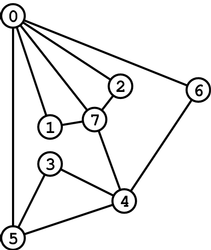This post will be mostly code. Please use proper indenting cuz Python otherwise will make your life hell. If you’re using Sublime go to, set Convert Indentation to tabs.
Gist : I have used the collections.defaultdict dict DT for implementing a dict of sets.
Vertices have been stored as adjacency list kind of elements as a dictionary. The code is raw and may have errors ( though no compilation error as of the post’s writing). Please comment for additional details. This is purely for testing purposes.
 A Graph.
A Graph.
from collections import defaultdict
#The Graph will be a dictionary of sets
class Graph():
def __init__(self, connections, directed = False):
self.graph = defaultdict(set)
self.directed = directed
self.add_connections (connections)
def add_connections(self, connections):
for node1,node2 in connections:
self.add_connection(node1,node2)
def add_connection(self, node1, node2):
self.graph[node1].add(node2)
if not self.directed:
self.graph[node2].add(node1)
def remove(self, node):
#removes all references to the node
#Use iteritems for dict items like k,v in dictname.iteritems():
for n,cons in self.graph.iteritems():
try:
#Removing from a set involves setname.remove(element)
cons.remove(node)
except KeyError:
pass
try:
#Removing from a dictionary involves rem dict_element_name
del self.graph[node]
except KeyError:
pass
def isconnected(self, node1, node2):
if node1 in self.graph[node2] or node2 in self.graph[node1]:
return True
return False
def dfs(self,start):
#If start node does not exist, return None (search is futile)
if start not in self.graph:
return None
#Start with an empty set
visited = set()
#To return unse ( which is not a set
unset = []
#Initially fill stack with start vertex
stack = [start]
#While stack is not empty keep repeating this algorithms
while stack:
#Take the first element of stack (pop means last inserted , aggressive)
vertex = stack.pop()
#If vertex has not been visited yet, add it to visited and look for all the element in graph[vertex]
if vertex not in visited:
visited.update(vertex)
unset.append(vertex)
stack.extend(self.graph[vertex] - visited)
return unset
def bfs(self, start):
if start not in self.graph:
return None
visited = set()
queue = [start]
unset = []
while queue:
vertex = queue.pop(0)
if vertex not in visited:
visited.update(vertex)
unset.append(vertex)
queue.extend(self.graph[vertex] - visited)
return unset
#Should work but not tested
def findpath(self,v1, v2):
m = bfs(v1)
if v2 in m:
return m[:m.index(v2)+1]
return None